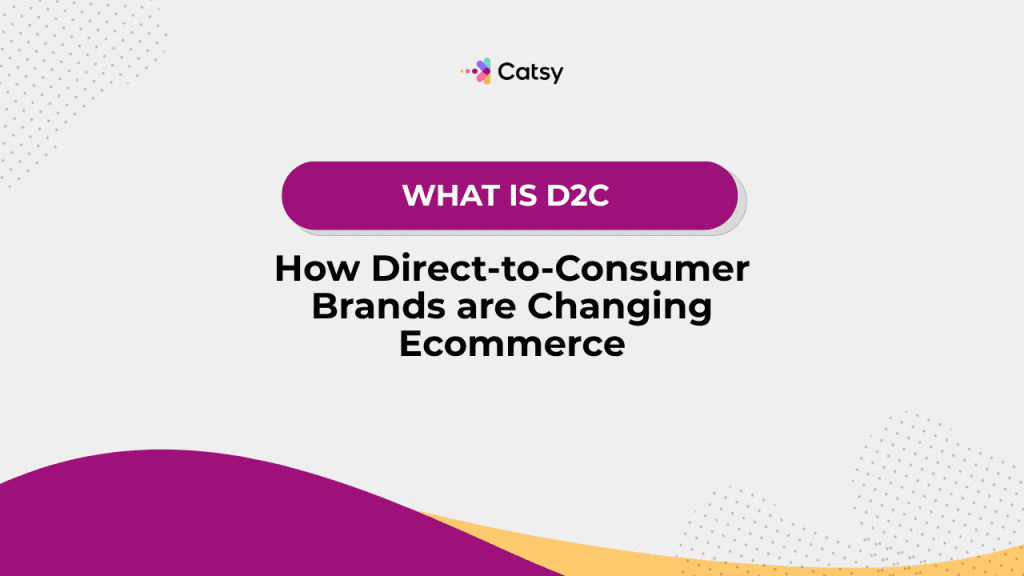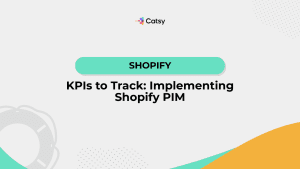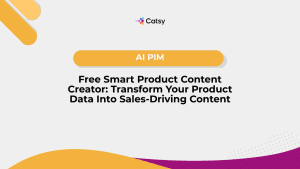What Is D2C? The Rise of Direct-to-Consumer Ecommerce Brands
Let’s face it, shopping has changed a lot since the days of strolling through the mall. These days, brands don’t need to try to find their place on the crowded retail shelves or charm middlemen to sell their stuff.
Instead, they go straight to you and me through any of our devices. That’s the reason you should pay more attention to Direct-to-Consumer (D2C) ecommerce.

So, What Is D2C, Anyway?
D2C stands for Direct to Consumer. Simply saying it refers to brands cutting out the middlemen (like wholesalers and retail stores) and selling their products directly to customers. They are usually doing that through their own website or app.
Think of it like this: instead of your favorite sneakers going through three different hands before reaching you, the brand ships them straight from their warehouse to your front door. Less fuss, more trust.
In this Article
What Makes D2C Brands Tick?
Here’s what D2C brands do differently (and often better):
- They own the customer relationship: No one’s standing between them and their buyers, so they get the juicy insights and can tailor the experience.
- They control their vibe: Messaging, branding, packaging, it’s all on point because the brand is in full control.
- They go digital-first: Most D2C brands start online. Their website is their storefront.
- They stay nimble: Need to tweak a product? Try a new marketing angle. They don’t have to ask permission. They just do it.
D2C Brands That Are Crushing It
Still not sure if the whole Direct-to-Consumer thing is legit? Don’t worry, we’ve got receipts. Let’s talk about a few familiar names that didn’t just try the D2C route, they owned it. These brands didn’t follow the old-school rules. Instead, they went straight to the people, and the people loved it.
Make Catsy DAM and PIM Software an Extension of Your Team
Book a Free DemoWarby Parker
The glasses brand made buying glasses online cool (and not wildly expensive).
They basically said, “Why are glasses $400 again?” Then they fixed it. By letting you try on frames at home and order online, they took the awkwardness out of optometry. It’s like choosing your outfit for the day from your own closet, only this one includes hipster glasses you didn’t pay a fortune for.
Glossier
Glossier didn’t just launch a makeup brand, they built a movement. They treated their customers like besties, not buyers. With a cult-like Instagram following and crowd-sourced product ideas, they turned DMs and comments into a strategy. When you make people feel seen, they’ll buy your lip gloss and tag you in their selfies.
Allbirds
Allbirds turned simple wool shoes into a cozy lifestyle brand. Comfortable? Check. Eco-friendly? Check. Weirdly stylish for something made out of merino wool? Also check. They leaned hard into sustainability and word-of-mouth love, and boom, everyone was suddenly wearing sneakers that felt like slippers. Who knew sheep could be so fashionable?
Casper
Casper sold mattresses online, and made it look easy. Yes, mattresses. The thing you used to lie down on in a store while avoiding eye contact with a salesperson. They tossed that whole experience and said, “What if we ship it to your door in a box?” People were skeptical… until they weren’t. It turns out the only thing people like more than sleeping is not talking to mattress salespeople.
Each of these brands skipped the middleman, kept full control of their vibe, and built something real with their audience. Instead of waiting for retail chains to notice them, they went directly to the customer, and never looked back.
Why More Brands Are Going D2C
1. They’re the boss.
When brands go direct, they’re not just part of the process, they run the show. From setting prices to choosing eco-friendly packaging, every decision is in their hands. No negotiating with retail chains, no diluted branding. They control how their product looks, feels, and lands in your hands, just the way they intended.
2. They know their people.
D2C brands don’t have to guess what their customers want; they’ve got the receipts (a.k.a. first-party data). Every click, cart ad, or product review is a chance to learn. What colors are popular? Which product gets abandoned in carts? D2C brands know, and they adjust all of their customer’s dmands in real time. It’s like having a direct line to your customer’s brain without needing to do the poll.
3. They make more money.
Here’s the deal: no middlemen means no middleman fees. Instead of splitting profits with retailers, distributors, and whoever else gets a cut in the traditional model, D2C brands keep more of what they earn. That means more cash to reinvest in better products, customer perks, or even just staying profitable.
4. They work fast.
Want to launch a new product line based on a trending TikTok sound? Go for it. With fewer layers of approvals and zero retail red tape, D2C brands can move from idea to execution at lightning speed. They can test new product flavors, run flash ecommerce sales, or pivot marketing strategies overnight. Basically, they’re the ecommerce version of “move fast and don’t break things.”
5. They build fans, not just customers.
D2C isn’t just about selling stuff, it’s about creating a vibe. The best D2C brands turn transactions into relationships. They respond to DMs, repost UGC, and name products after inside jokes with their followers. It’s not just business; it’s community. And that emotional connection? It turns one-time shoppers into loyal brand evangelists.
D2C vs. Traditional Retail: What’s the Real Difference?
Let’s paint a picture:
- In D2C, you buy directly from a brand’s website. In traditional retail, you go to a store or third-party site.
- D2C means total brand control. Retail? You’re at the mercy of the middleman.
- D2C gets customer data straight from the source. Retail? Not so much.
- D2C marketing is sharp, digital, and personal. Retail marketing tends to be broad and less targeted.
- Speed? D2C is like a sports car. Retail is more like a freight train.
What Does D2C Marketing Look Like?
Just launching a website and crossing your fingers isn’t going to cut it. D2C brands know they’ve got to hustle. So instead of relying on foot traffic (because, you know, it’s the internet), they get smart, scrappy, and a little bit creative with how they connect with people. Here’s what that looks like:
Social media is their stage.
Whether it’s a behind-the-scenes TikTok, an Instagram Reel showing how to use the product or a Facebook Live Q&A, D2C brands meet people where they’re already scrolling. It’s not just “buy this now”, it’s storytelling, demos, funny moments, and relatable content that makes you stop and say, “Wait… what brand is this?” (kind of like when you see a hilarious dog meme and realize it’s secretly an ad).
Email marketing, but make it personal.
These aren’t your average boring promo blasts. Think birthday surprises, “Hey, you forgot something in your cart” nudges and little thank-you notes that make you feel like a VIP. It’s like getting a message from a friend who just happens to be really good at selling skincare (or snacks, or shoes… you get the idea).
Influencers as your trusted BFFs.
You may not have met them IRL, but their recommendations still hit. D2C brands work with creators who feel genuine, not mega-celebrities with scripts, but real people who actually use the product and can tell you why it’s worth the hype. It’s like getting a rec from that one friend who always knows the best stuff before anyone else.
Content marketing that actually entertains.
Think of it as a blog post that teaches you something new, a how-to video that solves a problem, or a meme that perfectly sums up your Monday mood. D2C brands use content to create moments, not just sell. (Because sometimes, a good laugh is more memorable than a coupon code.)
Performance ads with personality.
Yes, they run paid ads, but the smart ones make it feel like you’re not being sold to. Instead of using generic sales talk that customers are immune to, these ads are tailored and specific. They have eye-catching visuals and sometimes even too-relevant message that makes your target customers immediately engaged. Kind of like when an oddly specific ad shows up for exactly what you were just talking about and you’re both confused and amazed.
How to Build a D2C Strategy That Works
- Make your website super user-friendly. Fast, pretty, and easy to use. Think of walking into your favorite local cafe where everything feels familiar.
- Show off your products. Use beautiful photos, videos, and clear descriptions. More than anything, customers don’t want to expect one and get a completely different product. They don’t need negative surprises at their door when they buy from your store.
- Tell your story. People don’t just buy products, they buy into brands. Share your mission.
- Nail the delivery game. Clear shipping info, smooth returns, and fast support can make or break trust.
- Use smart tools like PIM and DAM. Tools like Catsy are like a well-organized closet, everything is in the right place, and easy to grab when you need it.
What Trips D2C Brands Up (And How to Deal With It)
- Ads cost an arm and a leg. Instead of relying only on ads, try building community and content that sticks.
- Too much to juggle. Inventory, shipping, customer service—it’s a lot. Invest in tools that help you stay sane.
- Nobody knows your name (yet). It takes time to build trust. So show up consistently with great content and top-notch service.
What’s Next for D2C?
- More personalized shopping. With AI, brands can recommend products like your bestie would.
- Online meets offline. Think pop-up shops and branded experiences IRL.
- Community is king. D2C brands are focusing more on loyalty programs and letting fans help shape the brand.
How Catsy Helps D2C Brands Win
Catsy gives brands their own behind-the-scenes command center:
- PIM keeps product data tidy, accurate, and consistent.
- DAM keeps images, videos, and logos organized and easy to find.
- Syndication tools push content out to wherever you sell—fast.
Imagine having a super-organized team member who never sleeps and always keeps your online store looking sharp. That’s what Catsy does.
Final Takeaway
You might think that D2C is just a new way to sell. But what you need to realize is that it’s a smarter way to build lasting relationships with your target customers. It allows brands to stay skillful, and truly stand out from all of the other brands their customers might find interesting. D2C is a perfect step in your business. If you’re launching your first product or want to make your brand stand out, it is a strategy that you need to have in your business.
Want more tips, tutorials, and insights on product content and e-commerce operations?
Stay connected. We post regularly to help brands like yours scale smarter.
Are You Ready To streamline your product content management?
Continue Reading

Frequently Asked Questions
D2C (Direct-to-Consumer) means the brand sells straight to you. There are no retail stores or third-party sellers involved. B2C (Business-to-Consumer) includes any business selling to customers, even if it’s through Amazon or a department store.
Absolutely. Even legacy brands are jumping on the D2C train to stay close to their customers. It just takes the right tools and mindset.
Nope. While a lot of startups love it, established businesses can use it too. It’s for anyone who wants more control and stronger customer relationships.
It’s personal, data-driven, and nimble. D2C marketing meets customers where they are—on social media, in their inboxes, and everywhere in between.
You’ll need a user-friendly website, great product content, solid fulfillment, and a platform like Catsy to keep things running smoothly behind the scenes.
Because it feels more authentic, trustworthy, and often cheaper. Plus, they can connect with the brand’s mission and values.
Not at all. It’s growing fast and getting smarter by the day. As shoppers demand better experiences, D2C is here to stay.
Subscribe For More Content
Sign up for monthly tips on how to drive revenue with product content.




